Samsung SSD XP941 Review: The PCIe Era Is Here
by Kristian Vättö on May 15, 2014 12:00 PM ESTRandom Read/Write Speed
The four corners of SSD performance are as follows: random read, random write, sequential read and sequential write speed. Random accesses are generally small in size, while sequential accesses tend to be larger and thus we have the four Iometer tests we use in all of our reviews.
Our first test writes 4KB in a completely random pattern over an 8GB space of the drive to simulate the sort of random access that you'd see on an OS drive (even this is more stressful than a normal desktop user would see). We perform three concurrent IOs and run the test for 3 minutes. The results reported are in average MB/s over the entire time.
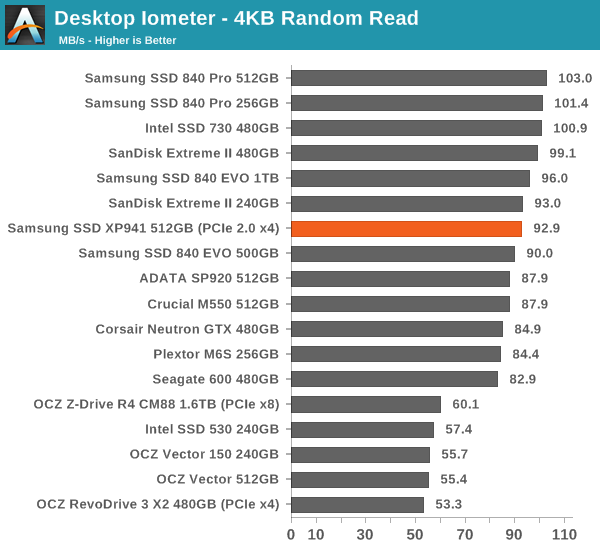
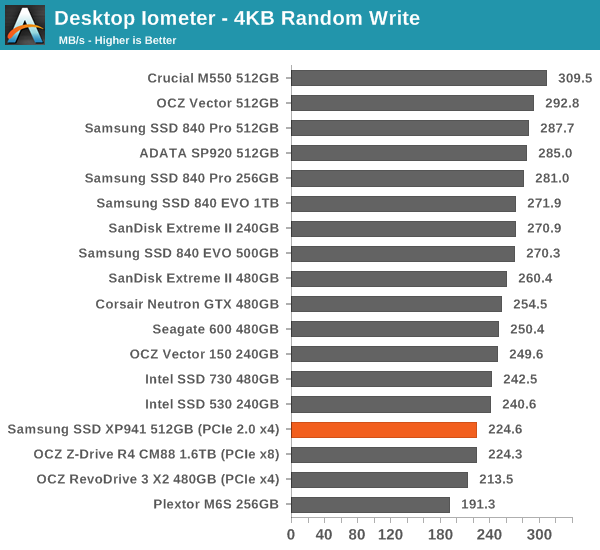
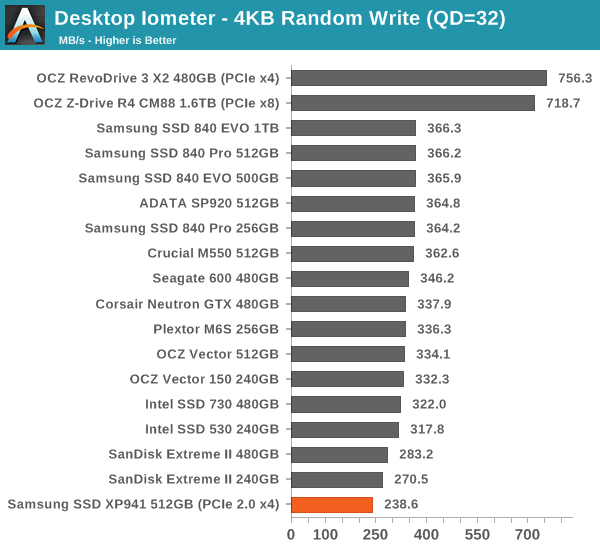
The random performance of XP941 doesn't stand out. Especially random write speeds are quite low by today's standards and queue depth scaling is close to non-existent. That said, I don't believe that high queue depth performance is really important for client workloads as our internal workload analysis shows that even under heavy use the average queue depth tends to be no more than 5. Our Storage Benches also show that even though the random performance isn't excellent, the strong sequential performance thanks to the faster PCIe interface makes up for the difference.
Sequential Read/Write Speed
To measure sequential performance we run a 1 minute long 128KB sequential test over the entire span of the drive at a queue depth of 1. The results reported are in average MB/s over the entire test length.
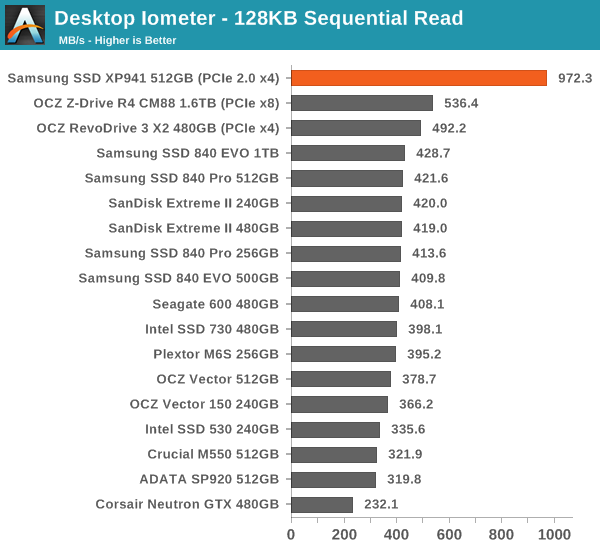
The sequential speeds are the highest we have ever tested in a consumer SSD. Even the 8-controller Z-Drive R4 behemoth can't beat the XP941, which really speaks for the efficiency of a single controller design. If you were to increase the queue depth, the Z-Drive would easily beat the XP941 since higher queue depth would increase parallelism and the Z-Drive could take advantage of all of its eight controllers. However, I was able to reach speeds of up to 1560MB/s with the XP941 at queue depth of 32, which is pretty much as fast as you can go with PCIe 2.0 x4 without tweaking any settings (the PCIe bus can be overclocked to achieve even higher speeds, though there can be a negative impact on random performance. We will investigate this at a later date).

AS-SSD Incompressible Sequential Read/Write Performance
The AS-SSD sequential benchmark uses incompressible data for all of its transfers. The result is a pretty big reduction in sequential write speed on SandForce based controllers. The XP941 does brilliantly in AS-SSD as well but now the strength of eight controllers starts to show for the Z-Drive. Even then, the XP941 is still about twice as fast as the fastest SATA 6Gbps SSD.
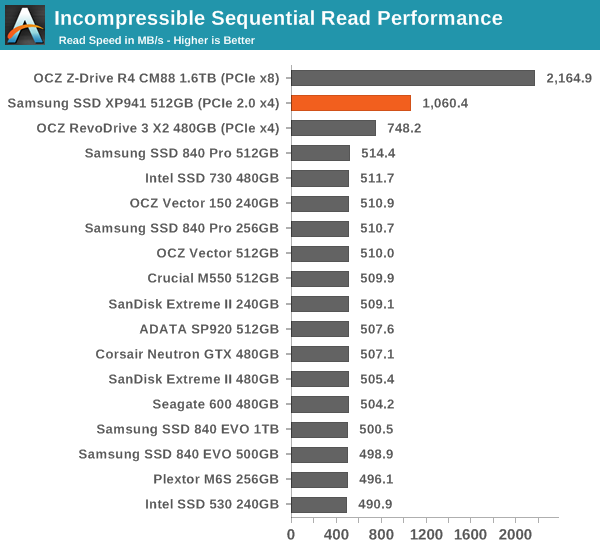
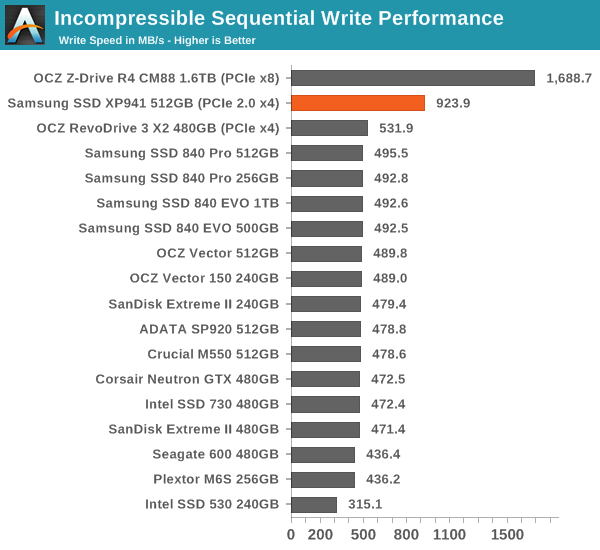










110 Comments
View All Comments
McTeags - Thursday, May 15, 2014 - link
I think there is a spelling mistake in the first sentence. Did you mean SATA instead of PATA? I don't know all of the tech lingo so maybe I'm mistaken.McTeags - Thursday, May 15, 2014 - link
Please disregard my comment. I googled it...BMNify - Thursday, May 15, 2014 - link
sata-e[serial], sata[serial], pata[parrallel] ,SCSI [several, and chainable to 15+ drives on one cable, we should have used that as generic] ,shugart these are all drive interfaces and there are more too going back in the day....metayoshi - Thursday, May 15, 2014 - link
"It's simply much faster to move electrons around a silicon chip than it is to rotate a heavy metal disk."While SSD performance blows HDDs out of the water, the quoted statement is technically not correct. If you take a single channel NAND part and put it up against today's mechanical HDDs, the HDD will probably blow the NAND part out of the water in everything except for random reads.
What really kills HDD performance isn't the just rotational speed as much as it is the track-to-track seek + rotational latency of a random workload. A sequential workload will reduce the seek and rotational latency so much that the areal density of today's 5 TB HDDs will give you pretty good numbers. In a random workload however, the next block of data you want to read is most likely on a different track, different platter, and different head. Now it has to seek the heads to the correct track, perform a head switch because only 1 head can be on at a time, and then wait for the rotation of the disk for that data block to be under the head.
A NAND part with a low number of channels will give you pretty crappy performance. Just look at the NAND in smartphones and tablets of today, and in the SD cards and USB thumb drives of yesteryear. What really makes SSDs shine is that they have multiple NAND parts on these things, and that they stripe the data across a huge number of channels. Just think RAID 0 with HDDs, except this time, it's done by the SSD controller itself, so the motherboard only needs 1 SATA (or other like PCIe) interface to the SSD. That really put SSDs on the map, and if a single NAND chip can do 40 MB/s writes, think about 16 of them doing it at the same time.
So yes, there's no question that the main advantage of SSDs vs HDDs is an electrical vs mechanical thing. It's just simply not true that reading the electrical signals off of a single NAND part is faster than reading the bits off of a sequential track in an HDD. It's a lot of different things working together.
iwod - Friday, May 16, 2014 - link
I skim read it. Few things i notice, No Power usage testing. But 0.05w idle is pretty amazing. Since the PCI-E supply the power as well i guess they could be much better fine grained? Although Active was 5.6W. So at the same time we want more performance == faster controller while using much lower power. it seems there could be more work to do.I wonder if the relative slow Random I/O were due to Samsung betting its use on NVMe instead of ACHI.
iwod - Friday, May 16, 2014 - link
It also prove my points about Random I/O. We see how Random I/O for xp941 being at the bottom of the chart while getting much better benchmarks results. Seq I/O matters! And It matters a lot. The PCI -E x4 interfaces will once again becomes bottleneck until we move to PCI-E 3.0 Which i hope we do in 2015.Although i have this suspicious feeling intel is delaying or slowing down our progression.
nevertell - Friday, May 16, 2014 - link
Can't you place the bootloader on a hard drive, yet have it load the OS up from the SSD ?rxzlmn - Friday, May 16, 2014 - link
'Boot Support: Mac? Yes. PC? Mostly No.'Uh, a Mac is a PC. On a serious tech site I don't expect lines like that.
Penti - Friday, May 16, 2014 - link
Firmware differences.Haravikk - Friday, May 16, 2014 - link
It still surprises me that PCs can have so many hurdles when it comes to booting from various devices; for years now Macs have been able to boot from just about anything you plug into them (that can store data of course). I have one machine already that uses an internal drive combined with an external USB drive as a Fusion Drive, and it not only boots just fine, but the Fusion setup really helps eliminate the USB performance issues.Anyway, it's good to see PCIe storage properly reaching general release; it's probably going to be a while before I adopt it on PCs, as I'm still finding regular SATA or M.2 flash storage runs just fine for my needs, but having tried Apple's new Mac Pros, the PCIe flash really is awesome. Hopefully the next generation of Mac Pros will have connectors for two, as combined in a RAID-0 or RAID-1 the read performance can be absolutely staggering.